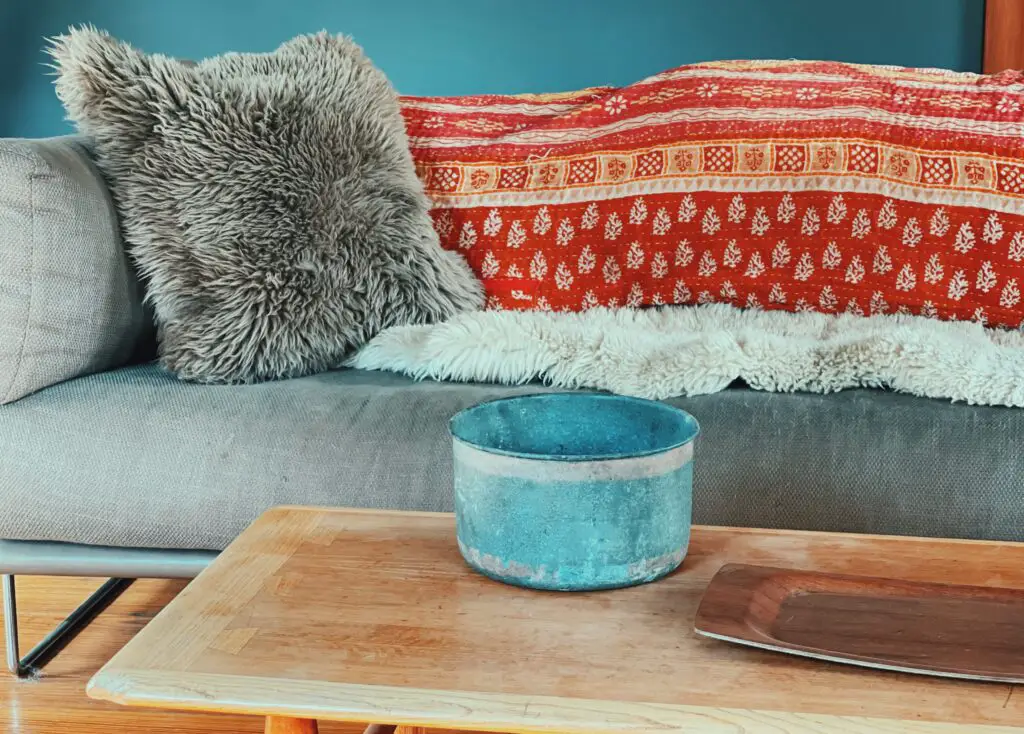Wabi-sabi is a style of decorating that embraces authenticity and simplicity. Essentially, the Japanese term means finding beauty in the world’s imperfections. Instead of purchasing the latest trendy decor piece, wabi-sabi adopters mix handmade and artisan pieces to create a functional and unique space. We can keep our tastes authentic with wabi-sabi, and since it’s not a definitive design style, we can be ultra-creative with it.
Here are my favorite ways to transform a farmhouse into a wabi-sabi-style refuge.
Get Rid of Clutter – Wabi-sabi may be about appreciating imperfections, but it doesn’t mean you should tolerate clutter and live in an unorganized space. Get rid of things you don’t need or want. I think I’ve mentioned this before, but one of my favorite books on organizing is “Goodbye, Things” by Fumio Sasaki. If you want to learn how to clear out clutter, he’ll be the one to guide you.

Mix and Match – Mix and match handmade objects with vintage and artisanal pieces. Display souvenirs from a favorite vacation with ceramics you made or art from a local fair. A chipped stoneware jug alongside a bit of frayed homemade cloth napkins is wabi-sabi beautiful.
Wabi-sabi is all about finding balance in what could seem like dissonance. Instead of having all your furniture match, add some personality. Mix a fabric-covered couch with a wooden chair, metal table, and a lambswool rug.
Include Lots of Nature-Inspired Accent Pieces – Nature is the definition of imperfection. Natural wood, stone, and plants are all wabi-sabi. Add some greenery and flowers plucked from the garden to a coffee table and display unique rocks you pick up on your walks and hikes. Add a little wabi-sabi with a stack of wood next to the fireplace or some branches in a tall vase in the corner. Big perfect bouquets or fake anything is not wabi-sabi.
Use What Others Would Discard – Many people would throw away two old wooden sawhorses. But you can turn items like these into wabi-sabi beauty with the effortless addition of an old bit of barnwood – voilà, it’s an instant table!

Controlled Discord – If we manipulate some elements, we can create a space where things aren’t perfectly arranged or placed but are still comfortable. A table filled with children’s watercolor detritus along with a half-drunk mug of cocoa and a candlestick that is nearing its end nub to me is very wabi-sabi. While it’s a bit messy, there is beauty in the mess. Now, if there were a bag of Doritos, a computer charging, and a plastic grocery bag hanging out on the table, I’d say that was a mess, given that all of it exudes a cheap, plasticky vibe rather than one of controlled discord.
Having some loose pillows arranged in irregular patterns, a carpet that’s not quite stretched, or even curtains where the fabric is fraying, are options that won’t affect the comfort of your home. They have the look of effortless, loving simplicity. When you place things simply and with love and intention, they give off that same simple, loving, intentional vibe.

Great Way to Save Money – Another advantage of adopting the wabi-sabi philosophy is that you’re not out buying tons of decorative items for your home! Using many elements from nature and keeping walls and surfaces relatively free of excessive tchotchkes means money saved. In wabi-sabi you spend money ONLY on those few quality items you absolutely love rather than lots of trendy things.
Choose Items That Age Gracefully – Choose quality pieces that last and add depth and personality to your space over time. Examples include things like a hand-carved cutting board or serving bowl. Choose items made from natural elements like wood and stone over synthetic materials like plastic. If taken care of, a wooden serving bowl will look better over time than a plastic bowl.

Add a Sense of History – Wabi-sabi is a style of decorating that speaks to history. Old, used pieces that might be discarded are often retrieved and utilized in wabi-sabi style homes. For example, for the countertops in my friend’s house, she used gorgeous rough-hewn reclaimed solid French oak doors that were refinished with a dark stain. The imperfections speak to the age of the wood and create depth and interest. The wood will continue to change over time as it interacts with its environment. These doors were headed to the landfill until she rescued them!
So, got any wabi-sabi style tips to add? Please share in the comments below.



I’ve decorated “wabi-sabi” my whole adult life AND THATS A LONG TIME!! Been married 57 years. I also call it “early marriage”. You have some great fun ideas.
Congratulations on 57 years of marriage! That’s truly inspirational. We are so glad you loved the ideas & we would love to see what you’ve done in your original farmhouse with “wabi-sabi”!